
As you contemplate the vast Australian outback, it might surprise you to learn about the intricate lifecycle of an emu.
From the humble beginnings of an egg hatching to the complexities of adulthood, each stage holds its own mysteries waiting to be unraveled.
Imagine witnessing the early chick development, the nurturing parental care, and the fascinating social interactions.
Stay with us as we journey through the stages that shape the life of this remarkable bird, from birth to maturity.
Key Takeaways
- Emus undergo significant physical and behavioral changes post-hatching.
- Both parents actively participate in feeding for rapid growth.
- Curious exploration aids in developing survival skills.
- Social interactions and bonding rituals shape emus from birth to maturity.
Emu Egg Hatching
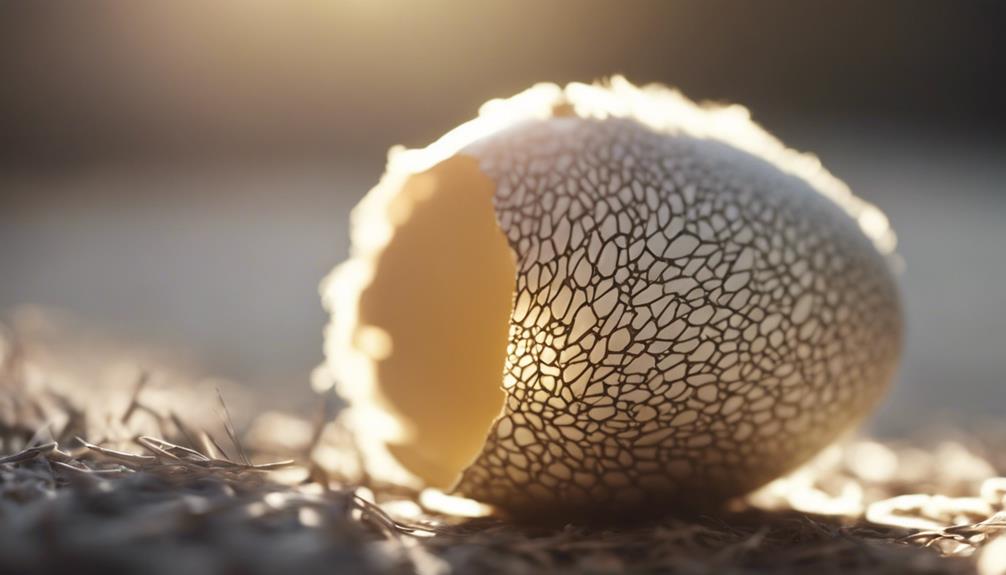
When an emu egg is ready to hatch, the process begins with the chick inside breaking through the shell using its egg tooth. This marks the end of the incubation process, during which the egg has been carefully kept warm and at the optimal temperature for the embryo to develop. The egg turning, a vital part of the incubation process, ensures that the embryo receives uniform heat distribution, promoting healthy growth.
Throughout the incubation period, the embryo undergoes significant developments, transforming from a mere collection of cells into a complex organism ready to break free from its shell. The precise regulation of temperature within the egg plays a crucial role in these stages, influencing the chick's growth and overall health.
As the chick nears the final stages of hatching, its movements become more pronounced, and the eggshell gradually weakens. Eventually, with a burst of energy, the chick emerges, a testament to the intricate processes of incubation and embryo development that have taken place unseen within the egg.
Early Chick Development
During early chick development, the newly hatched emu undergoes rapid physical and behavioral changes as it adapts to its environment and begins its journey towards maturity.
Emu chicks exhibit instinctual behaviors essential for survival, such as pecking at objects to explore their surroundings and learning to follow their parent for protection. Feeding habits play a crucial role during this phase, as the chicks primarily rely on their parents for a diet rich in insects and vegetation to support their growth.
Predator avoidance becomes a vital skill for young emus, who learn to hide under bushes or freeze to blend in with the surroundings when sensing danger. This behavior helps them evade potential threats from predators in their habitat. Additionally, chicks start developing their distinctive plumage during this period, which aids in camouflage and protection.
Feeding and Growth
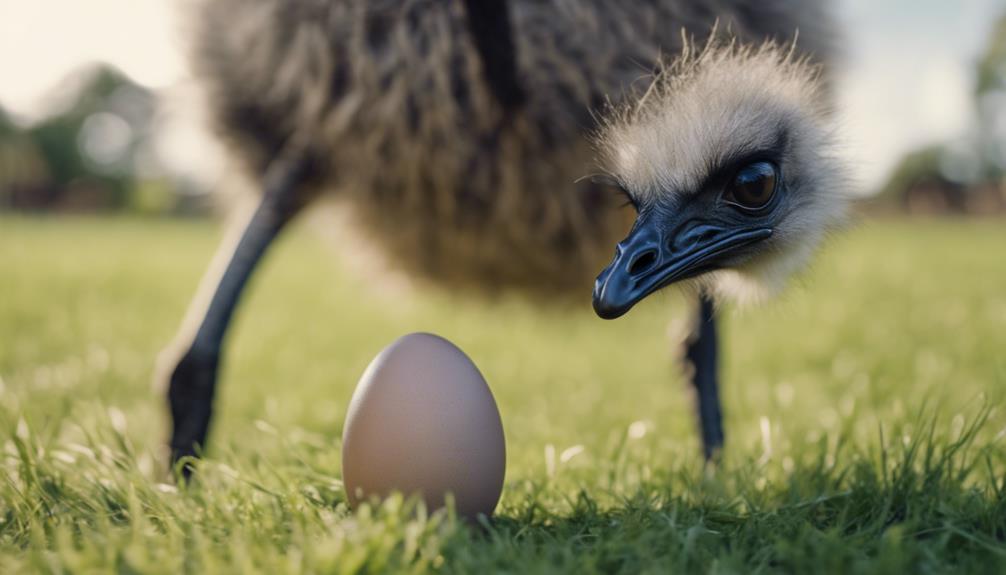
Feeding plays a critical role in the growth and development of emu chicks, providing essential nutrients for their maturation. Emu chicks exhibit fascinating feeding habits that contribute to their unique growth patterns. Here are some key observations:
- Diet Diversity: Emu chicks have a diverse diet consisting of insects, vegetation, fruits, and seeds. This varied diet ensures they receive a wide range of nutrients essential for their growth.
- Parental Feeding: Emu chicks are cared for by both parents who actively participate in feeding. This parental involvement not only provides nourishment but also teaches the chicks important feeding behaviors.
- Feeding Frequency: Emu chicks require frequent feedings throughout the day to support their rapid growth. They've a high metabolic rate, necessitating regular meals to sustain their energy levels and development.
Understanding these feeding habits and growth patterns is crucial for ensuring the healthy development of emu chicks from birth to maturity.
Exploration of Environment
Emu chicks actively explore their environment, exhibiting curious behaviors that contribute to their understanding of the world around them. This exploration is crucial for developing essential survival skills and adapting to their habitat. As they venture out, the chicks display a keen interest in various elements of their surroundings, such as different vegetation types, potential food sources, and safe resting spots. Their movement patterns are characterized by quick, darting movements as they navigate through the terrain, honing their agility and reflexes.
During habitat exploration, emu chicks showcase a remarkable ability to adapt to environmental challenges. They quickly learn to identify potential threats and sources of nourishment, showcasing a mix of caution and curiosity in their interactions with new stimuli. This adaptive behavior not only aids in their immediate survival but also lays the foundation for their future development. By observing the movement patterns and environmental adaptations of emu chicks, one can gain valuable insights into the early stages of their life cycle.
Social Interactions
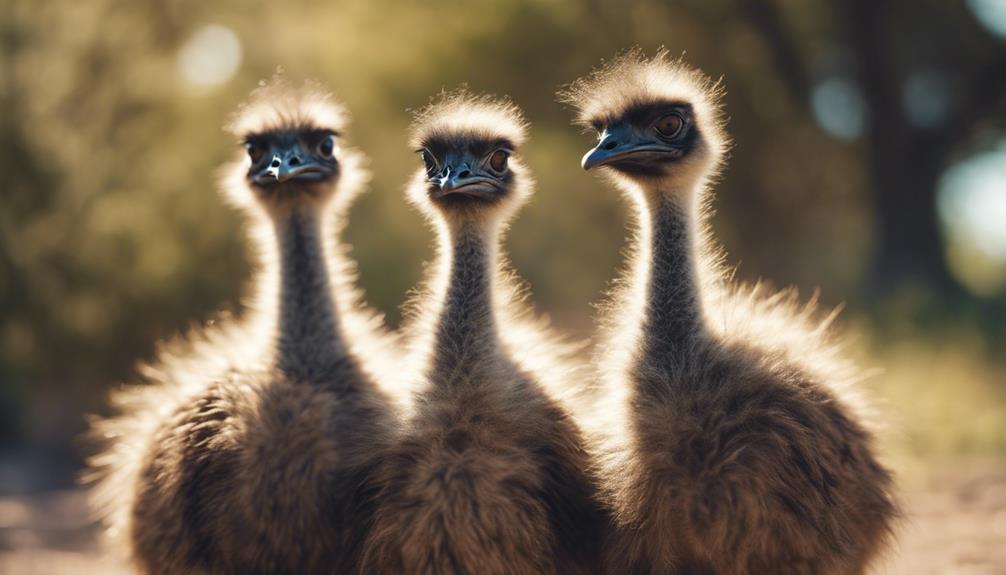
In the context of their habitat exploration, the social interactions among emu chicks provide valuable insights into their behavioral development. Emu chicks engage in fascinating group dynamics, allowing them to learn crucial communication strategies from a young age. These interactions are essential for their survival in the wild and help them navigate their environment effectively.
- Group Dynamics: Emu chicks often move together in a coordinated manner, displaying a sense of unity and cooperation within the group.
- Communication Strategies: Through vocalizations and body language, emu chicks convey information about food sources, potential dangers, and social bonding.
- Social Hierarchies: As emu chicks interact, social hierarchies begin to form, influencing behaviors and relationships within the group.
Moreover, emu chicks partake in bonding rituals, strengthening the connections between individuals and fostering a sense of belonging within the group. These early social interactions play a vital role in shaping the chicks' social skills and behaviors as they mature.
Juvenile Feathers Appearance
During their developmental stage, emu chicks exhibit distinct variations in the appearance of their juvenile feathers. Feather growth in emu chicks is a fascinating process to observe. Initially, the downy feathers that cover their bodies give way to the growth of true feathers. These feathers start to appear on their wings and gradually spread to cover their entire body. As the chicks age, their plumage changes in color and texture. The once fluffy and soft feathers become coarser and more structured, providing better insulation and protection.
Juvenile emus go through a series of plumage changes as they mature. Their feathers transform from a dull gray-brown color to a darker shade, with hints of white on their necks and chests. These changes in coloration are essential for camouflaging and blending into their natural habitat. The gradual evolution of their feathers reflects their growth and adaptation to the environment. Observing these intricate feather developments in juvenile emus offers a glimpse into the intricacies of their early stages of life.
Learning to Forage
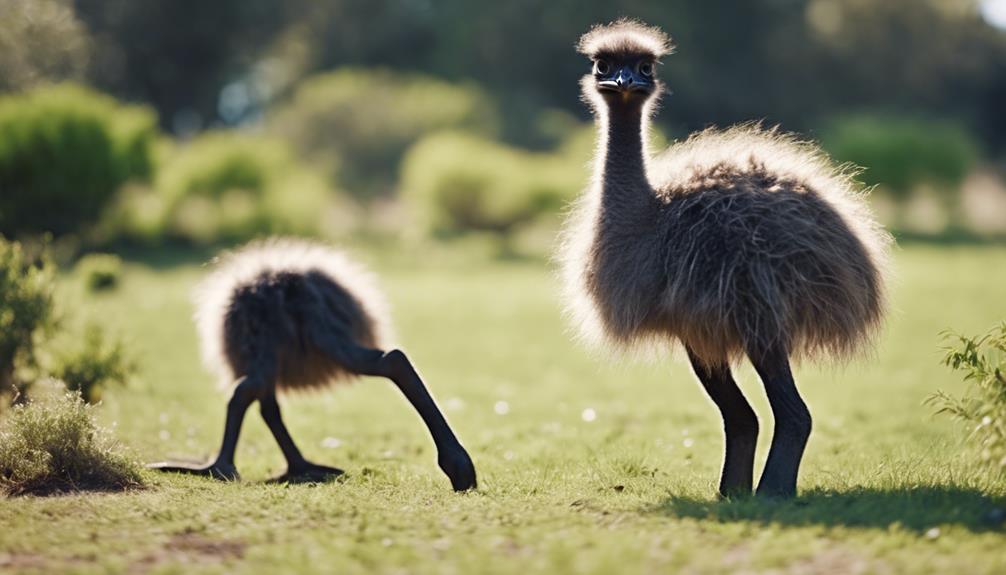
As emu chicks mature, they gradually learn to forage for food in their natural environment. This crucial skill is essential for their survival and growth. Here's a glimpse into how these fascinating creatures navigate the world of foraging:
- Observational Learning: Emu chicks closely watch their parents and other adult emus foraging for food. Through this observation, they learn about suitable food sources, how to locate them, and the appropriate foraging techniques to employ.
- Food Sources: Emu chicks primarily feed on a diet of insects, seeds, fruits, and plants found in their environment. They learn to identify these food sources by sight and sometimes by trial and error, tasting different items to understand what's safe and nutritious for them.
- Foraging Techniques: Emu chicks develop various foraging techniques as they grow older. They use their beaks to peck at the ground, dig for roots and tubers, and even shake bushes to uncover hidden insects. These techniques evolve and become more refined as the chicks gain experience and confidence in their foraging abilities.
Sexual Maturity Signals
Emu chicks, as they reach sexual maturity, exhibit distinct behavioral and physical signals that indicate readiness for reproduction. Hormonal changes play a crucial role in this transition. You may notice shifts in their behavior, such as increased vocalization, territorial displays, and courtship dances. These actions are driven by hormonal surges that prepare the emus for mating.
Physical changes also become evident as emus mature. One noticeable transformation is in their appearance. Male emus may develop larger and more vibrant plumage, especially around their neck and head regions. This change isn't only visually striking but also serves as a signal to potential mates of their reproductive fitness. Female emus, on the other hand, may display a heightened receptiveness to male advances, indicating their readiness to engage in the mating process.
As you observe these subtle yet significant shifts in behavior and physical attributes, you're witnessing the fascinating journey of emu chicks as they mature into adults ready to partake in the intricate dance of reproduction.
Mating Behavior Initiation
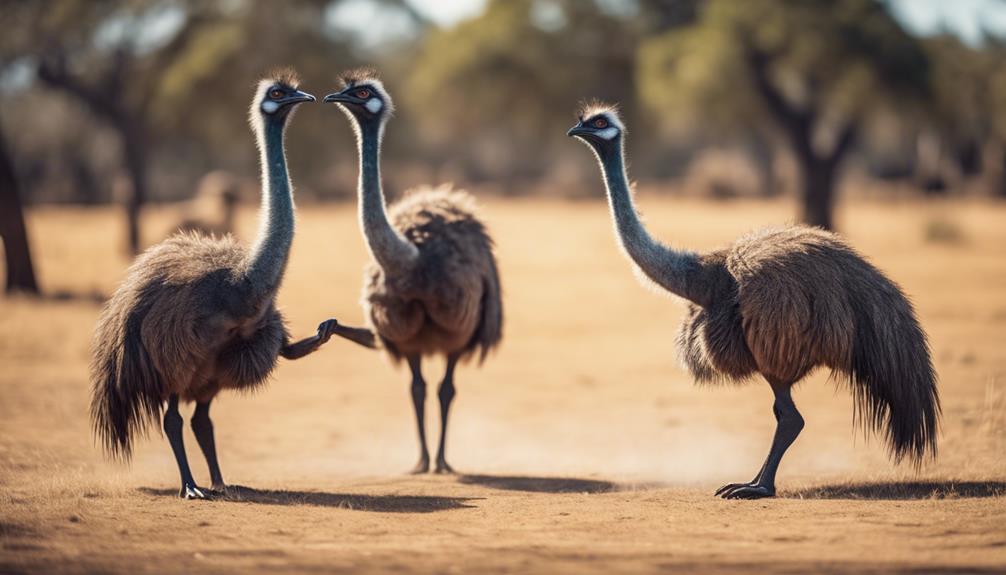
Mating behavior initiation in emus typically involves intricate courtship rituals marked by precise movements and vocalizations. During the breeding season, male emus exhibit fascinating behaviors to attract a mate and establish dominance in their territory. Here's what you need to know:
- Courtship Rituals: Male emus engage in elaborate displays to court females, including puffing out their feathers, emitting deep booming sounds, and swaying their bodies in a rhythmic manner.
- Mate Selection: Female emus carefully observe the displays of potential mates, looking for signs of strength, health, and vitality before making a choice.
- Territorial Disputes: Male emus fiercely defend their territories from rival males during the breeding season, often engaging in aggressive behaviors such as charging, kicking, and vocal challenges.
Through these courtship rituals, mate selection processes, and territorial disputes, emus ensure the continuation of their species in a manner that's both captivating and essential to their survival.
Nesting and Incubation
During nesting and incubation, emus meticulously prepare and safeguard their eggs for optimal development. Parental bonding is crucial during this period, with both male and female emus sharing nesting duties. The female emu lays around 8-10 dark green eggs in a clutch, and the male is responsible for incubating them for approximately 56 days. Emus exhibit remarkable protective instincts, carefully rotating the eggs to ensure even heat distribution and constant temperature regulation.
Emus construct their nest using leaves, grass, and bark to provide insulation and protection for the eggs. Nest maintenance is essential to prevent predators from detecting the nest. The male emu plays a significant role in defending the nest, often staying close by to deter potential threats.
Observing emus during nesting and incubation reveals the intricate behaviors and strategies they employ to ensure the survival of their offspring. Their commitment to parental care and the meticulous attention to detail throughout this process highlights the remarkable adaptability and intelligence of these fascinating birds.
Parental Care

Parental care in emus involves a cooperative effort between both sexes to ensure the well-being and survival of their offspring. Emus exhibit remarkable bonding behaviors and nurturing instincts towards their young, creating a strong familial bond essential for the chicks' development. This care stems from the protective instincts ingrained in emu family dynamics, ensuring the chicks are safeguarded from potential dangers in their environment.
- Emu parents take turns incubating the eggs, with the male emu being the primary caregiver responsible for incubation.
- Once the chicks hatch, both parents actively participate in caring for and protecting the young emus.
- Emu parents teach their offspring essential skills such as foraging for food and avoiding predators through hands-on guidance and demonstration.
Through their attentive parental care, emus impart crucial survival knowledge to their young, shaping them into independent and resilient individuals.
Adulthood Establishment
Upon reaching maturity, emus undergo a period of physical and behavioral changes that mark the establishment of adulthood. Adult emus display distinct behaviors that differentiate them from younger individuals. They exhibit a more confident demeanor, walking with purpose and asserting their dominance within their social groups. Adult behavior involves participating in intricate mating rituals where males showcase elaborate dances to attract females. These courtship displays are a crucial part of emu social structure and help strengthen pair bonds. During this stage, emus also exhibit increased territorial behaviors, marking and defending their territories from intruders.
Mating rituals play a vital role in the establishment of adulthood for emus. These rituals involve vocalizations, such as booming calls from male emus that can be heard over long distances, signaling their availability for mating. Additionally, males may engage in physical displays like puffing up their bodies and swaying rhythmically to impress potential mates. As adulthood is solidified, emus become more focused on mating and reproduction, contributing to the continuation of their species.
Frequently Asked Questions
Do Emus Have Any Predators During Their Early Stages of Development?
During their early stages of development, Emu chicks face predation risk from various predators. However, with dedicated parental care, Emus increase the survival chances of their offspring, ensuring the continuation of the species.
How Long Does It Take for an Emu Chick to Learn How to Forage Successfully?
As an emu chick, you typically take around 6-12 months to master successful foraging. During this time, you rely on parental care for guidance. Your feeding habits evolve gradually, marking a crucial step towards independence and survival.
Are There Any Specific Rituals or Displays That Emus Perform During Mating Behavior Initiation?
When emus seek a mate, they engage in intricate courtship displays, including mesmerizing mating dances and vocalizations. Their territorial behavior during this time is fascinating to witness, showcasing the beauty of nature's rituals.
How Long Do Emus Typically Stay With Their Parents Before Becoming Independent?
Emus typically stay with their parents for about 6-12 months before gaining independence. During this time, they learn crucial survival skills like foraging and predator evasion, gradually adapting to their environment under parental care.
What Are Some Common Challenges Emus Face When Establishing Themselves as Adults in Their Environment?
When establishing themselves as adults, emus face challenges in social interactions and competition for resources. They must develop survival skills like navigation to thrive in their environment, ensuring they can secure food and successfully reproduce.
Conclusion
As you have observed, the lifecycle of an emu is a fascinating journey from birth to maturity. Despite their remarkable ability to adapt and thrive in their environment, some may question the importance of studying these birds.
However, understanding the lifecycle of emus not only sheds light on their unique behaviors and characteristics, but also plays a crucial role in conservation efforts to protect these magnificent creatures for future generations to appreciate and learn from.





